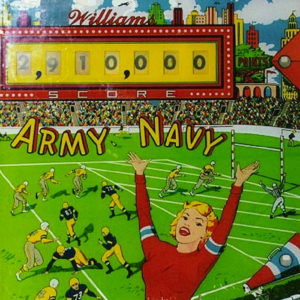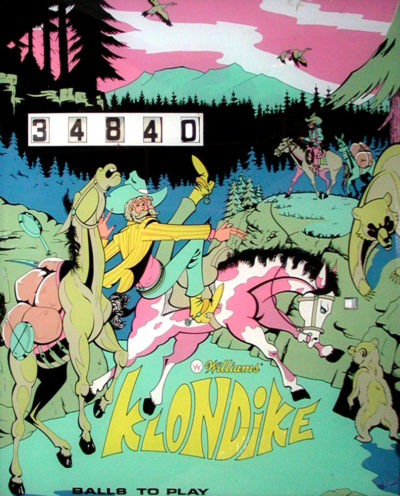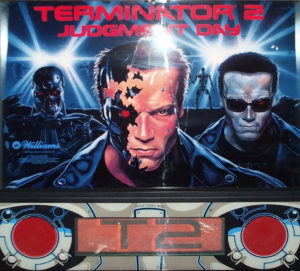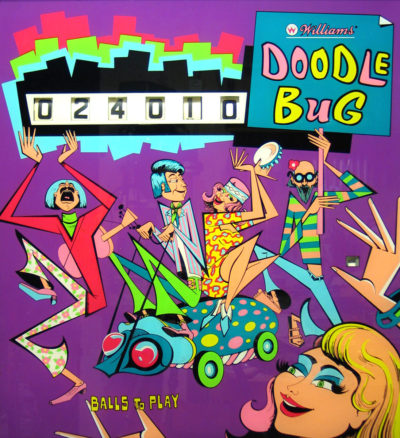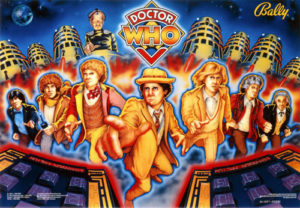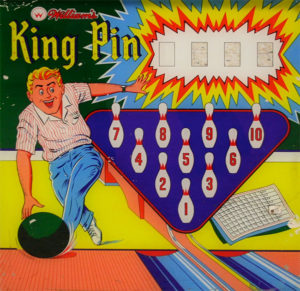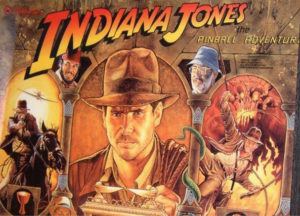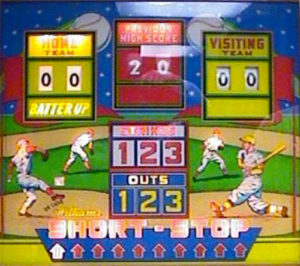- Release date: July 1991
- System: Williams WPC (Dot Matrix)
- Design: Steve Ritchie
- Programming: Dwight Sullivan
- Artwork: Doug Watson
- Mechanics: Carl Biagi
- Music: Chris Granner
- Sound: Chris Granner
- Production run: 15,202
-
The table is the first Williams WPC machine designed to feature a dot-matrix display. But due to the long design phase, Gilligan’s Island was the first manufactured with a DMD. Terminator 2: Judgment Day was the first game to feature an autoplunger (replacing the traditional plunger), as well as a ball-firing cannon (dubbed, “Gun Grip Ball Launcher”). Finally, T2 was the first game to feature a video mode, a mini video game featured on the DMD. Arnold Schwarzenegger provided voices for the game. Some playfield design elements were based on Ritchie’s 1980 classic, Firepower. T-1000 was not included in the artwork of the table, with the exception of a small image of actor Robert Patrick because of pre-release secrecy of the movie. The character was only included in the display animation because when the DMD programming was finalizing the liquid metal character was already public knowledge.This Norm Clark and Christian Marsche creation was also produced in an add-a-ball version called Love Bug as well as a four-player version called Dipsy Doodle. This symmetrical playfield design has a captive ball under the playfield which, when activated, rolls over a switch to score a bonus batch of points based on the value of the button when the feature is lit. The top kickout hole randomly selects bonus features to make the game more intriguing. A popup post between the flippers prevents ball drain down the middle of the playfield, but this post may be retracted just at the wrong time if the down-post targets are hit. An extra ball may be achieved if the center target is lit. This target also activates the “doodlebug” under the playfield. Finally, a free ball gate is incorporated into the machine if the appropriate combination of pop bumpers and rollovers are made. A fast-paced game that was popular in its day.There are 7 Doctors, as one can plainly see from the backglass… quite conveniently, they are numbered 1-7. Each Doctor has the effect of changing the rules of one area of the Playfield, making a list of the rules all the more annoying and probably confusing. First some general information about the Doctors… there are many ways to “spot” doctors throughout the game – one is awarded at the start of any ball, and can be spotted through the Transmat target or Video Mode. At the start of a ball (or when a ball has been locked), you get to choose the “current” doctor – his picture will flash on the backglass. When a doctor- spotting shot is made, the current doctor will become solidly lit (so his attributes are carried over for the rest of the game), and the “current” doctor becomes the previously unlit doctor directly to the left of the previous one. There are 2 ways to spot all seven doctors – either go through them all one-by-one, or shoot the Emperor Daleks jackpot. Either way, all of them will be lit for the rest of the game, and you receive an additional bonus of 2OM, as well as a small animation, which plays even after a tilt! After all 7 doctors are spotted, they can be spotted a second (third, etc) time, and running through all 7 a second time awards another 2OM bonus. Also, each doctor spotted in the game (this count may be more than 7) is worth a 1M bonus at the end of the last ball (so don’t tilt it!), and this bonus (unlike the regular bonus) is multiplied by the Playfield X.This electromechanical two-player game was designed by Steve Kordek. The game reminds one of an older game, as an animated golfer is on board that you aim to hopefully sink a ball in the appropriate hole. The nine scattered holes are tough to sink, especially the back ones. The lower your score in strokes, the better with this game (no handicap is given). Free games may be awarded set by the operator for low-stroke counts after completing so many holes. A neat and rare game.12,716 of these Mark Ritchie-designed games were produced in wide-body format. This machine has a lot of the action associated with the first three Indiana Jones adventures produced by Lucas and Spielberg and is rated in the top 10 machines of the ‘90s. Four multiball modes grace this machine as well as a ton of video clips designed by Brian Eddy. Twelve different scenes from the movies are represented. Completing these scenes awards a six-ball multiball sequence. A three-ball multiball sequence may be had by hitting the center drop targets and popping a ball into the drop hole behind them. The path of adventure is lit by hitting the letters in the word “adventure.” Doing so opens the path up the right ramp to the tilt-a-matic playfield in the upper left. The object here is to use the flipper buttons to guide the ball to glory.



